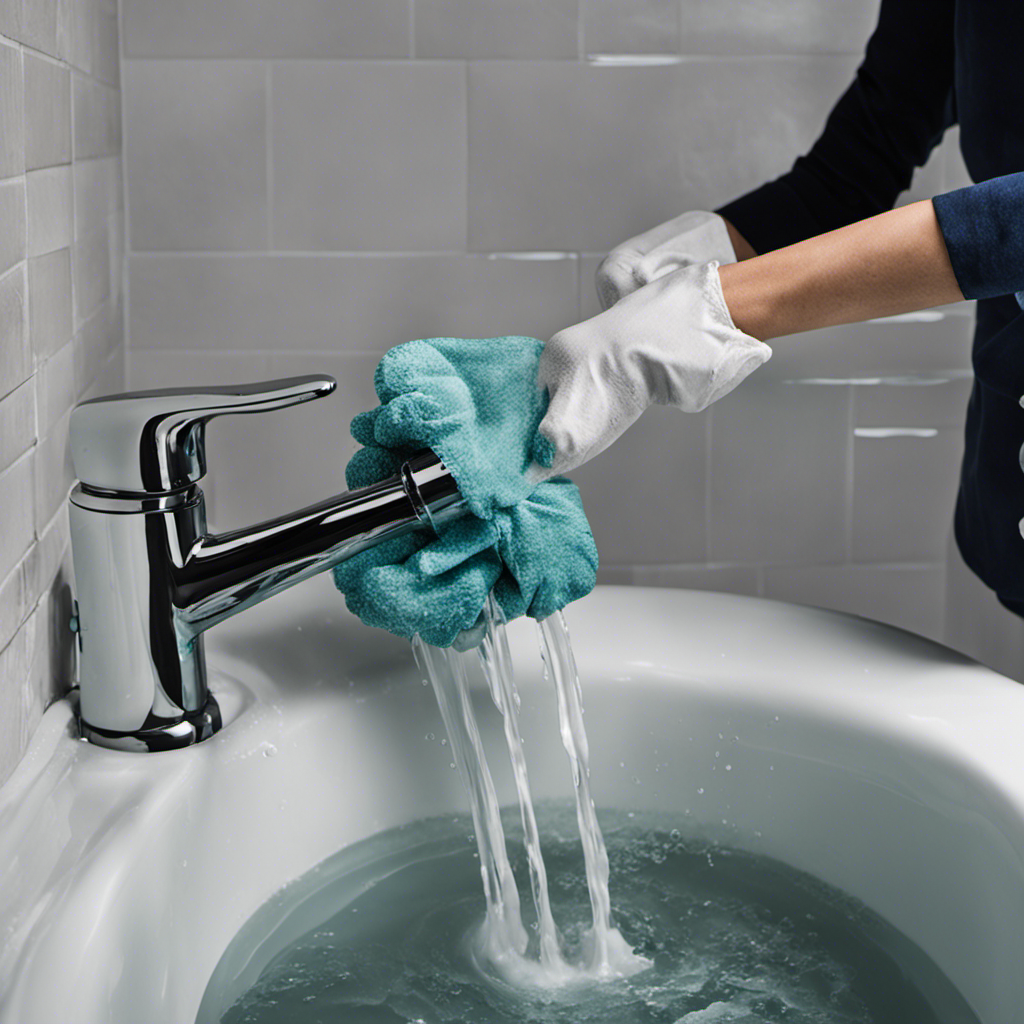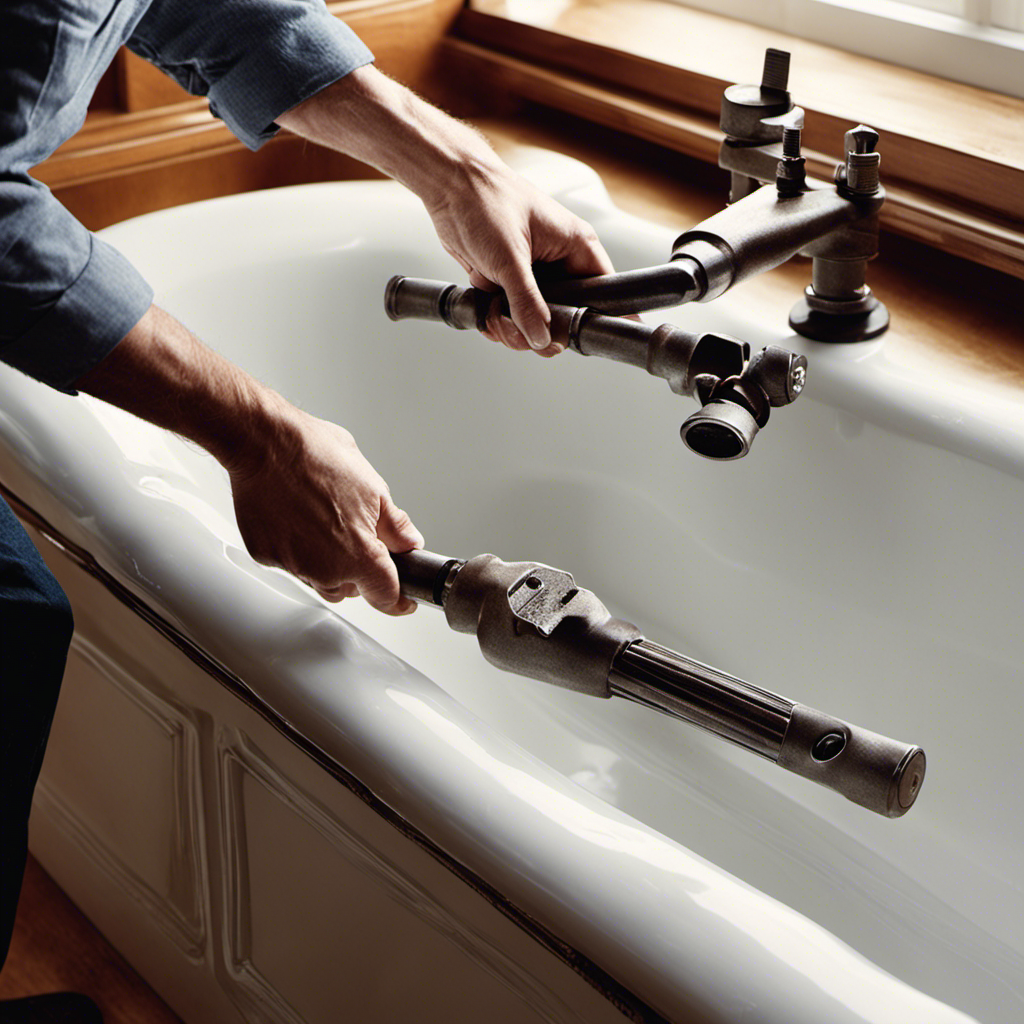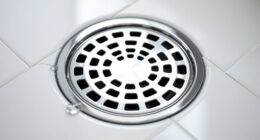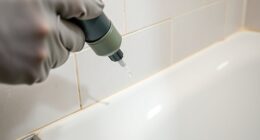I’ve been there – standing ankle-deep in water, desperately trying to unclog a bathtub drain. But fear not, because I’ve got you covered.
In this article, I’ll share my tried-and-true methods for tackling even the most stubborn clogs. We’ll assess the severity of the blockage, gather the necessary tools, and dive right into the unclogging process.
From plungers to drain snakes, I’ll guide you through each step with precision and expertise. Say goodbye to clogged tubs and hello to smooth-flowing drains.
Let’s get started!
Key Takeaways
- Slow or no water drainage indicates a severe clog.
- Proper tools and materials are essential for a successful unclogging process.
- Plunging is a cost-effective and efficient way to unclog bathtubs.
- Chemical drain cleaners should be a last resort due to their potential harm to pipes.
Assess the Severity of the Clog
Before you start, it’s important to assess how severe the clog in your bathtub is. This will help determine the best course of action to take.
Severity assessment involves examining the water flow and drainage. If the water is draining slowly or not at all, it indicates a more severe clog.
Potential causes of bathtub clogs include hair, soap scum, and debris buildup in the drainpipe.
To assess the severity, try pouring a bucket of water into the drain and observe how quickly it drains. If it drains slowly, the clog is likely moderate. However, if the water doesn’t drain at all, the clog is severe.
Understanding the severity of the clog will guide you in selecting the appropriate unclogging method.
Gather the Necessary Tools and Materials
First, you’ll need to make sure you have all the tools and materials needed for this task. Assessing clog severity and using a plunger effectively are key steps in unclogging a bathtub.
To assess the severity of the clog, you can start by checking the water flow in the bathtub. If the water is draining slowly or not at all, it indicates a more severe clog.
Next, gather the necessary tools and materials. You will need a plunger, preferably a cup plunger with a sturdy handle. Additionally, have a bucket or a large container nearby to collect any excess water. It’s also helpful to have gloves to protect your hands during the process.
Once you have all the tools and materials ready, you can proceed to effectively use the plunger to unclog the bathtub.
Remove Any Visible Debris From the Drain
To effectively remove any visible debris from the drain, start by using a pair of gloves to protect your hands. Assessing clog severity is the first step in troubleshooting common bathtub drain issues. Look for signs such as slow draining or standing water in the tub. Once you have determined the severity of the clog, you can proceed with removing the debris.
Begin by removing the drain cover, if applicable, and use your gloved hand to reach into the drain and pull out any visible debris, such as hair or soap scum. Be sure to dispose of the debris properly. By removing the visible debris, you can clear the way for further unclogging methods such as plunging.
Transitioning into the next section, let’s now try using a plunger to dislodge the clog.
Try Using a Plunger to Dislodge the Clog
When it comes to unclogging a drain, one of the most effective techniques is using a plunger. The plunger works by creating a strong suction that can dislodge the clog and allow water to flow freely again.
However, there are also alternative methods that can be used if the plunger technique is not effective. These alternative methods include using a drain snake or a homemade mixture of baking soda and vinegar to break down the clog.
Plunger Technique Effectiveness
The plunger is typically very effective at unclogging a bathtub. It’s a simple tool that can save you from calling a plumber and spending a ton of money. Here are some key points about the effectiveness of using a plunger and common mistakes to avoid:
-
Plunger Technique Effectiveness:
- The plunging action creates pressure that dislodges the clog and helps water flow freely again.
- It is most effective when the plunger covers the entire drain opening to create a tight seal.
- Applying forceful and steady plunges can quickly break up the clog and clear the drain.
-
Common Mistakes when using a plunger:
- Not using enough water in the bathtub can hinder the plunging action.
- Plunging too forcefully can lead to water splashing out of the tub.
- Failing to create a proper seal between the plunger and the drain can reduce the effectiveness.
Alternative Unclogging Methods
Using alternative methods can be a helpful way for you to tackle clogs in your bathtub. If you don’t have a plunger on hand or would like to try something different, there are several home remedies that you can use to clear the clog.
One effective method is using a mixture of baking soda and vinegar. Simply pour half a cup of baking soda down the drain, followed by half a cup of vinegar. Let it sit for a few minutes, then flush with hot water.
Another option is to use a combination of salt and boiling water. Mix half a cup of salt with a pot of boiling water and pour it down the drain. This can help dissolve the clog and clear your bathtub.
These alternative methods can be a cost-effective and convenient way to unclog your bathtub.
Use a Drain Snake or Auger to Break up the Blockage
To break up the blockage in your bathtub drain, grab a drain snake or auger and get ready to tackle the clog head-on. These tools are highly effective in removing stubborn clogs and restoring the flow of water in your bathtub.
Here’s how to use a drain snake or auger:
-
Insert the snake or auger into the drain: Push the tool gently into the drain until you feel resistance from the clog.
-
Rotate and push: Rotate the snake or auger while pushing it further into the drain. This motion will help break up the blockage and clear the pipe.
-
Withdraw the tool: Slowly withdraw the snake or auger from the drain, pulling out any debris or hair that may have been causing the clog.
Common causes of bathtub clogs include hair buildup, soap scum, and foreign objects. By using a drain snake or auger, you can effectively remove these blockages and prevent future clogs.
Consider Using a Chemical Drain Cleaner as a Last Resort
Now, let’s discuss using a chemical drain cleaner as a last resort when trying to unclog a bathtub.
It’s important to note that while chemical drain cleaners can be effective, they also come with safety risks. Always read and follow the instructions carefully to avoid any accidents or harm to yourself and your plumbing system.
Chemical drain cleaners contain powerful chemicals that can dissolve clogs, but they can also damage pipes if used improperly. It’s crucial to wear gloves and protective eyewear when handling these products, and never mix different types of drain cleaners together.
If you’re concerned about the safety of chemical drain cleaners or prefer to try alternative unclogging techniques, there are several options available. For example, you can use a mixture of baking soda and vinegar, or a combination of hot water and dish soap to break down the clog. These methods are generally safer and environmentally friendly alternatives to chemical drain cleaners.
Use Natural Remedies to Unclog the Bathtub Drain
When it comes to unclogging a bathtub drain, there are several natural remedies that can be effective.
One popular method is using a combination of vinegar and baking soda. This mixture creates a chemical reaction that can help break down clogs and clear the drain.
Another option is to perform a hot water flush. This involves pouring boiling water down the drain to dissolve any buildup.
Lastly, a mixture of salt and dish soap can be used as a homemade drain cleaner. The abrasive nature of the salt combined with the cleaning power of the dish soap can help dislodge and remove clogs.
Vinegar and Baking Soda
Using vinegar and baking soda is an effective way to unclog your bathtub. These common household ingredients have numerous benefits and uses beyond just cooking. Here’s why vinegar and baking soda are a powerful combination for clearing your clogged drain:
-
Vinegar benefits:
- Natural disinfectant: Vinegar kills bacteria and prevents unpleasant odors.
- Non-toxic: Unlike chemical drain cleaners, vinegar is safe for you and the environment.
- Affordable: Vinegar is a cost-effective solution for unclogging drains.
-
Baking soda uses:
- Abrasive action: Baking soda’s gritty texture helps remove stubborn debris.
- Odor neutralizer: Baking soda absorbs unpleasant smells, leaving your drain fresh.
-
Chemical reaction:
- When vinegar and baking soda combine, they create a fizzing reaction that breaks down stubborn clogs.
To maximize the effectiveness of vinegar and baking soda, follow up with a hot water flush to flush away any remaining debris and ensure a clear drain.
Hot Water Flush
To ensure a clear drain, you can maximize the effectiveness of vinegar and baking soda by following up with a hot water flush.
Hot water temperature is crucial for this method to work effectively. It is recommended to use water at a temperature of around 120 to 140 degrees Fahrenheit. However, it is important to prioritize hot water safety.
Always test the temperature before pouring it down the drain to avoid burns or scalding. Additionally, make sure to handle hot water with care and use protective gloves if necessary.
The hot water flush helps to further break down any remaining debris and flush it out of the drain, leaving your bathtub unclogged and ready to use.
Salt and Dish Soap
Now that we’ve tried the hot water flush, let’s move on to another effective method for unclogging a bathtub drain: using salt and dish soap. This combination can help break down stubborn clogs and clear your drain. Here’s how it works:
- Mix equal parts salt and dish soap in a bowl to create a paste.
- Apply the paste directly to the clogged drain and let it sit for about 15 minutes.
- Boil some water and carefully pour it down the drain to flush away the mixture and any loosened debris.
The abrasive nature of salt and the grease-cutting properties of dish soap make this a powerful alternative for clearing clogs. Once you’ve successfully unclogged your drain, it’s important to prevent future clogs by practicing regular drain maintenance.
Transitioning into the next section, let’s explore some effective methods for preventing future clogs.
Prevent Future Clogs by Practicing Regular Drain Maintenance
Regular drain maintenance can help prevent future clogs in your bathtub. By practicing regular maintenance, you can ensure that your drains stay clear and free-flowing.
Here are a few simple tips to help you prevent clogs:
-
Use a drain strainer: Install a drain strainer in your bathtub to catch hair and other debris before it goes down the drain. This will help prevent clogs from forming in the first place.
-
Run hot water: Once a week, pour a kettle of boiling water down your bathtub drain. This will help dissolve any buildup and keep your drain clear.
-
Use a natural drain cleaner: Regularly use a natural drain cleaner, such as a mixture of baking soda and vinegar, to keep your drains clean and prevent clogs.
-
Avoid pouring grease down the drain: Grease can solidify and clog your drains. Instead, dispose of grease in the trash.
Frequently Asked Questions
How Long Does It Usually Take to Unclog a Bathtub?
It usually takes me around 30 minutes to unclog a bathtub. First, I troubleshoot the issue by checking for common causes of clogs like hair or debris. Then, I follow the necessary steps to remove the blockage.
Can I Use a Plunger if I Have a Clog in the Bathtub Drain?
Yes, you can use a plunger as a quick fix for a clogged bathtub drain. However, prevention is key. Regularly using a hair catcher and avoiding pouring grease down the drain can help prevent future clogs.
What Should I Do if the Drain Snake Doesn’t Work?
If the drain snake doesn’t work, there are alternative methods to try. However, if all else fails, calling a professional plumber is the best option to ensure the clog is effectively and safely removed.
Are Chemical Drain Cleaners Safe to Use on All Types of Pipes?
Chemical drain cleaners can be harmful to certain types of pipes. It’s important to consider alternatives like using a plunger or a drain snake before resorting to chemicals, to avoid potential damage.
How Often Should I Perform Regular Drain Maintenance to Prevent Clogs?
I perform regular drain maintenance to prevent clogs. It’s important to use drain screens and clean them regularly. The frequency of maintenance depends on usage and hair/shower products.
Conclusion
In conclusion, unclogging a bathtub can be a simple task if you have the right tools and knowledge. By assessing the severity of the clog and using techniques such as plunging or using a drain snake, you can effectively remove the blockage.
However, it is important to remember that chemical drain cleaners should only be used as a last resort, as they can be harmful to both the environment and your plumbing system.
Additionally, practicing regular drain maintenance can help prevent future clogs. So next time you encounter a clogged bathtub, don’t panic, just follow these steps and you’ll have a clear drain in no time.










